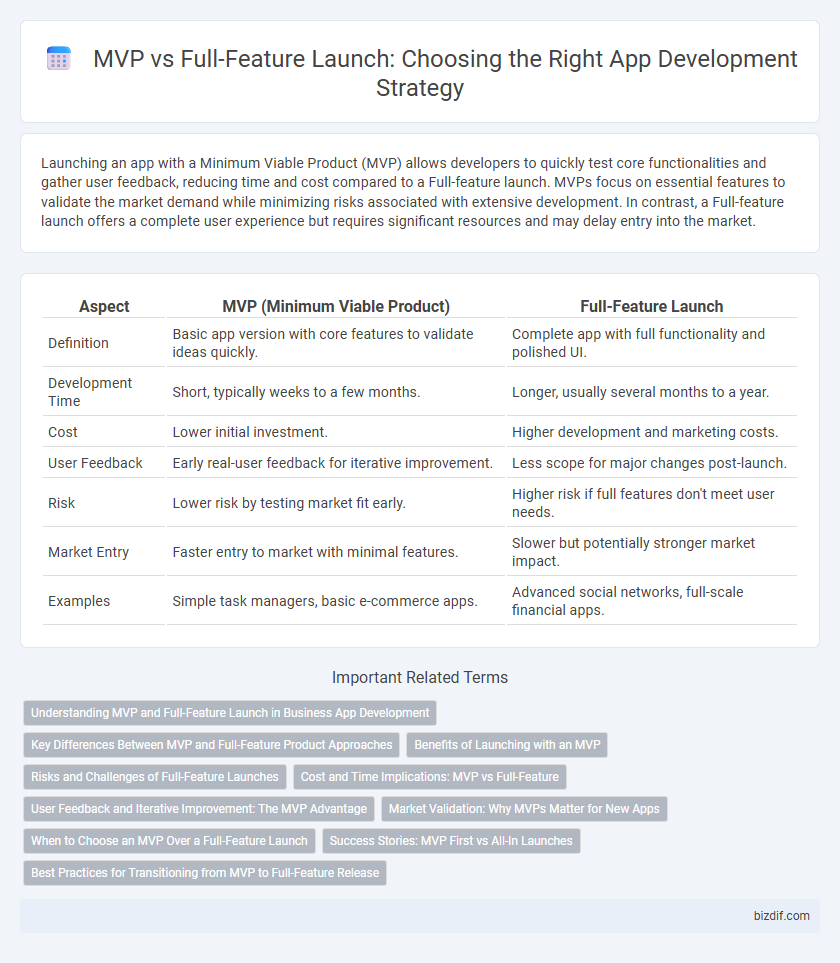Launching an app with a Minimum Viable Product (MVP) allows developers to quickly test core functionalities and gather user feedback, reducing time and cost compared to a Full-feature launch. MVPs focus on essential features to validate the market demand while minimizing risks associated with extensive development. In contrast, a Full-feature launch offers a complete user experience but requires significant resources and may delay entry into the market.
Table of Comparison
| Aspect | MVP (Minimum Viable Product) | Full-Feature Launch |
|---|---|---|
| Definition | Basic app version with core features to validate ideas quickly. | Complete app with full functionality and polished UI. |
| Development Time | Short, typically weeks to a few months. | Longer, usually several months to a year. |
| Cost | Lower initial investment. | Higher development and marketing costs. |
| User Feedback | Early real-user feedback for iterative improvement. | Less scope for major changes post-launch. |
| Risk | Lower risk by testing market fit early. | Higher risk if full features don't meet user needs. |
| Market Entry | Faster entry to market with minimal features. | Slower but potentially stronger market impact. |
| Examples | Simple task managers, basic e-commerce apps. | Advanced social networks, full-scale financial apps. |
Understanding MVP and Full-Feature Launch in Business App Development
MVP (Minimum Viable Product) in business app development focuses on delivering core functionalities to quickly validate market demand and gather user feedback, reducing initial investment and development time. A full-feature launch involves a comprehensive version with all planned features, aiming to provide complete user experience but requiring higher resources and longer development cycles. Prioritizing MVP allows businesses to iteratively improve based on real user insights before committing to the full-feature release.
Key Differences Between MVP and Full-Feature Product Approaches
MVP (Minimum Viable Product) focuses on delivering core functionalities quickly to validate market demand and gather user feedback, while a full-feature product offers a complete set of features aiming for a comprehensive user experience from the start. MVP development prioritizes speed, cost-efficiency, and iterative improvement, contrasting with full-feature launches that require extensive planning, higher budgets, and longer timelines. Key differences include scope, risk management, user testing intensity, and resource allocation, making MVP ideal for startups and full-feature releases suited for mature projects with established user requirements.
Benefits of Launching with an MVP
Launching with a Minimum Viable Product (MVP) accelerates time-to-market by prioritizing core functionalities, enabling early user feedback and iterative improvements. This approach minimizes development costs and reduces risk by validating key assumptions before committing to a full-feature launch. Focusing on MVP allows teams to adapt rapidly to user needs, ultimately driving product-market fit and increasing the likelihood of success.
Risks and Challenges of Full-Feature Launches
Full-feature launches carry significant risks including increased development time, higher costs, and the potential for numerous undiscovered bugs that can harm user experience and brand reputation. The complexity of managing multiple features simultaneously often leads to delays, scope creep, and difficulty in prioritizing critical fixes. In contrast, launching an MVP allows for iterative testing and user feedback, reducing the risk of costly post-launch failures associated with full-feature releases.
Cost and Time Implications: MVP vs Full-Feature
Developing an MVP (Minimum Viable Product) significantly reduces initial costs and accelerates time-to-market by focusing on core functionalities, enabling faster user feedback and iterative improvements. In contrast, a full-feature launch demands higher upfront investment and longer development cycles, increasing risk and potential resource waste if market fit is uncertain. Prioritizing MVPs helps optimize budget allocation and allows startups to validate concepts before committing to comprehensive features.
User Feedback and Iterative Improvement: The MVP Advantage
Launching an MVP (Minimum Viable Product) allows app developers to gather critical user feedback early, enabling data-driven enhancements before committing resources to full-feature development. This iterative improvement process minimizes risks and ensures the final app aligns with real user needs and market demands. Prioritizing MVP helps optimize development cycles, improve user satisfaction, and increase the likelihood of product success.
Market Validation: Why MVPs Matter for New Apps
MVPs accelerate market validation by delivering core features quickly, enabling real-time user feedback and iterative improvements. This approach reduces development costs and minimizes the risk of building unwanted features, ensuring alignment with user needs and market demand. Full-feature launches often delay feedback, increasing the chance of costly pivots or product failure.
When to Choose an MVP Over a Full-Feature Launch
Choosing an MVP over a full-feature launch is ideal when rapid market validation and user feedback are essential to minimize development costs and reduce time to market. MVPs allow startups and developers to test core functionalities with early adopters, enabling iterative improvements based on actual user behavior and preferences. This approach is particularly beneficial in uncertain markets or for innovative applications where assumptions need real-world validation before scaling to a full-feature release.
Success Stories: MVP First vs All-In Launches
Startups like Airbnb leveraged MVP-first strategies to validate market demand rapidly, launching with core features before iterating based on user feedback, which minimized initial costs and accelerated growth. Contrastingly, companies such as Facebook executed all-in launches with comprehensive feature sets, relying on massive initial user acquisition and engagement to dominate markets quickly. Data indicates MVP-first approaches often reduce time-to-market by 30-50%, while all-in launches benefit from stronger brand presence but carry higher risks of costly pivots.
Best Practices for Transitioning from MVP to Full-Feature Release
Effective transition from MVP to full-feature release requires implementing a structured product roadmap aligned with user feedback and priority features identified through analytics. Incorporating agile development practices enables iterative enhancements while maintaining stability and scalability of the application. Monitoring key performance indicators and user engagement metrics ensures data-driven decisions that optimize feature integration and enhance user experience.
MVP (Minimum Viable Product) vs Full-feature launch Infographic

 bizdif.com
bizdif.com